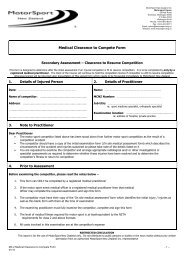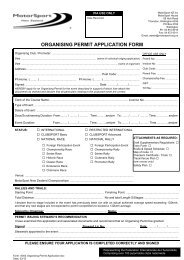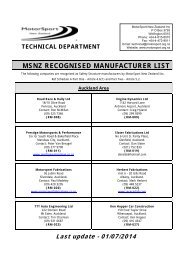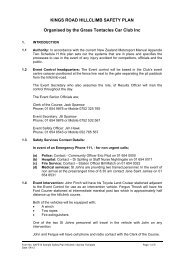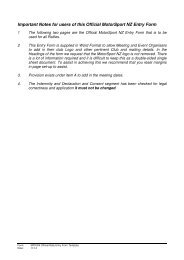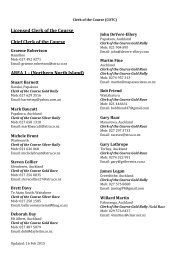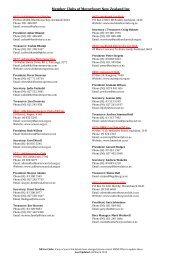Rally Organiser's Handbook - MotorSport New Zealand
Rally Organiser's Handbook - MotorSport New Zealand
Rally Organiser's Handbook - MotorSport New Zealand
Create successful ePaper yourself
Turn your PDF publications into a flip-book with our unique Google optimized e-Paper software.
• The finish area of a special stage. It must be safe and not in an area where carswill be at high speed. Avoid having the finish line just before a blind or sharpbend. Allow suitable slow down distance from the flying finish (300 m is therecommended minimum distance) before positioning the stop control in an areawhere there is sufficient room for the stop control personnel to park at least onevehicle off the road and carry out their duties safely. Ideally this will be in agateway or an area where the finish line crew can easily park in a position ofsafety clear of the road yet with an unobstructed view of the roadwayapproaching the line. Remember there will at times be more than onecompeting car parked at this location so it is important to choose this areacarefully. Consider that 500 metres less stage will not effect the quality of thecompetition but may allow a much safer placement of the flying finish and controlpoints• Prohibit service in congested areas, main roads and narrow roads, or on<strong>MotorSport</strong> NZ <strong>Rally</strong> Championship events on any area other than a designatedservice park.• Ensure adequate space for Service Areas or Service Parks and take into accountthe needs of the service crews for food, toilets etc.• The route should be arranged so that only one service crew is required for eachcompeting car.• Avoid mixing gravel and tarmac surfaces in the same stage.• Be careful to avoid car-breaking stages.ADVICE TO RESIDENTSReferences to this subjectChapter Eight of this BookletWhere the rally is using public roads for special stages it is important that residents aremade aware that the event will be passing and the effect of the road closures. This willrequire at least two separate contacts. In cases where there are non resident landowners with properties fronting onto the selected special stage roads organisers areadvised to seek from the Road Authority a list of these owners (usually from theratepayers database) and contact details so they can be contacted either in person or inwriting.The first contact should be a personal one wherein a representative of the organisingcommittee visits each resident and discusses the proposal. A letter should be left withresidents that explain the purpose of the road closure and outlines when the RoadAuthority is likely to publish the first public notice of closure. The letter should alsoinform the residents that they have the opportunity of making submissions to the RoadAuthority either in support of or objecting to the closure. Try to encourage thoseresidents who support the closure to write to the Roading Authority in support of yourapplication for road closure. (We suggest you have standard letters of support preparedthat the resident can sign in support of your application.) Remember that this is acommunication exercise rather than seeking permission for the event.PAGE 13RALLY ORGANISERS HANDBOOK2009 Edition




